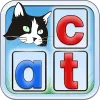Take a look inside 5 images
Montessori Crosswords
Pros: Putting Montessori and technology together seems contradictory, but it works beautifully.
Cons: More detailed data on student progress would be helpful.
Bottom Line: The surprisingly great combo of Montessori principles and technology helps kids learn phonics without overstimulation.
Parents or teachers can adjust the time kids are allowed to play with the graphics that pop up between rounds, from 15 seconds to no limit at all. Try giving kids more or less break time depending on what they need to make a smooth transition.
Although there’s no teacher dashboard or data tracking of kids' progress, teachers or parents can reset how words that are successfully completed are tracked (if they want to start over for another user).
Montessori Crosswords puts the language shelf of a Montessori classroom into kids' hands. Kids move beyond the ABC song and learn the sounds letters make and how to combine those sounds to make words. Starting with a picture and blank spaces for each letter of the word, kids then drag and drop the correct letter into place to spell the word. Tapping the letter allows them to hear its phonetic sound, or they can tap the blank space to hear the sound of the letter that they need for that space. Incorrect letters won't drop into place, so kids can try again.
There are three levels of increasing difficulty, for kids aged 3 to 10. Level 1 includes simple words with three sounds, like cat or fan. Level 2 moves into words with blended sounds, like fish or stop, and also offers the more challenging option of a crossword puzzle with two words. Level 3 introduces more complex words, like road or torch, and offers the challenge of a three-word crossword puzzle. Using the moveable alphabet, kids can also build their own words.
Most people don't equate technology with Montessori. But Montessori Crosswords does a lovely job of marrying Montessori principles and technology to create an app that can teach kids phonics without overstimulating students' senses. Visual and auditory inputs should appeal to kid users with different learning styles, and kids will be drawn to the colorful, lively interface.
Kids can access hints (seeing the word spelled out so they can match letters) by tapping the question mark. They can customize the experience, too, choosing capital or lowercase letters and print or cursive. What you won't find are a lot of unnecessary bells and whistles and special effects that overstimulate kids, even though kids get a little brain break after each word to play around with a fun on-screen graphic.











